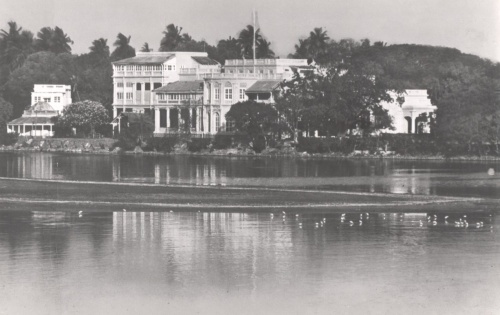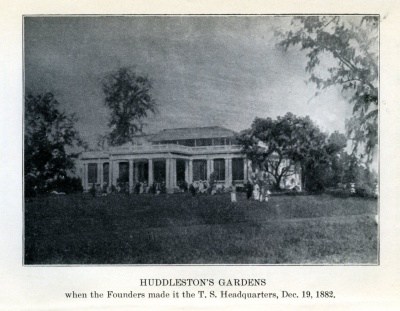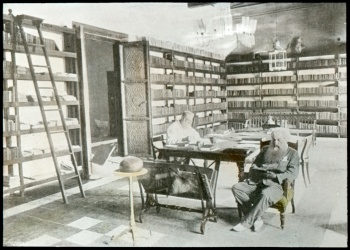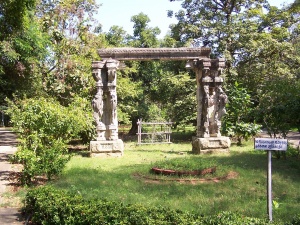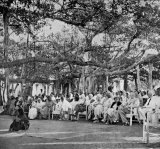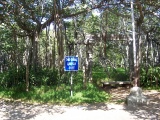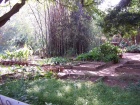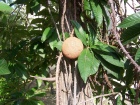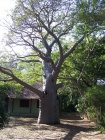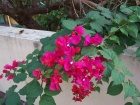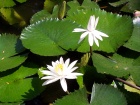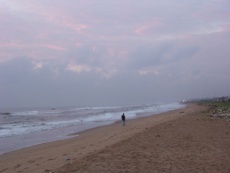Adyar (campus): Difference between revisions
Pablo Sender (talk | contribs) No edit summary |
|||
| (94 intermediate revisions by 5 users not shown) | |||
| Line 1: | Line 1: | ||
'''ARTICLE UNDER CONSTRUCTION''' | |||
<br> | <br> | ||
'''ARTICLE UNDER CONSTRUCTION''' | |||
<br> | <br> | ||
<br> | <br> | ||
On [[April 23]], 1882, [[Founders#The Founders|the Founders]] arrived by ship at Madras, where they met [[T. Subba Row]], Judge [[G. Muthuswamy Chetty]] and his sons [[G. Soobiah Chetty]] and [[G. Narasimhulu Chetty]], among others. On [[May 31]] the Chetty brothers took them to see a piece of property they recommended as the new headquarters site for the [[Theosophical Society]]: the "Huddlestone's Gardens". The Huddlestone family had been granted some property south of the Adyar River in the late 1780s, on which they built a country or "garden" house. But now the twenty-seven-acre property, containing a large house, two cottages, and other facilities, was on sale. | |||
'''Adyar''' is the name by which the headquarters estate of the [[Theosophical Society]] has been known since 1882. | |||
[[File:Adyar view across river.jpg|500px|right|thumb|Headquarters viewed across Adyar River]] | |||
== History == | |||
=== Purchase of the estate === | |||
On [[April 23]], 1882, [[Founders#"The Founders"|the Founders]], [[Helena Petrovna Blavatsky]] and [[Henry Steel Olcott]], arrived by ship at Madras, where they met [[T. Subba Row]], Judge [[G. Muthuswamy Chetty]] and his sons [[G. Soobiah Chetty]] and [[G. Narasimhulu Chetty]], [[Ragunath Row]], among others. | |||
''The Madras Times'' of April 24 or 25, 1882, describes their arrival as follows" | |||
<blockquote> | |||
THEOSOPHISM AT MADRAS. — Madame Blavatsky and Colonel Olcott, the well-known founders of the Theosophical Society in Bombay, arrived at Madras on Sunday morning at nine o'clock. In anticipation of their arrival, the natives assembled, and made arrangements to give their visitors a formal reception at five o'clock in the evening. Accordingly, at the hour fixed, the native community mustered strong at the pier, among whom were the Hon'ble Rajah Gajapathi Row, the Dewan Bahadur Ragunatha Row, and several leading members and merchants of the community. Boats went out to meet the steamer, the one destined for the visitors tastefully decorated. After an interchange of compliments and much cheering, the visitors were ushered into a saloon carriage, afterwards to a carriage and four, and driven to the residence fitted up for them. . . . The Deputy Inspector of Schools read the following address: ”We, the undersigned, who entertain great respect for you, welcome you to the capital of Southern India. We need hardly express our appreciation of your valuable services for our country, and we trust that your advent here will be a means of placing within our reach the advantages afforded for investigating the mysteries of nature and psychical powers latent in man".<ref>A Sketch of the Theosophic Organization at http://hpb.narod.ru/SketchTheosophicOrganization.htm</ref> | |||
</blockquote> | |||
While the Founders were there, the [[Madras Theosophical Society]] was formed, and the idea of moving the Headquarters from Bombay to Madras (previously suggested by G. Soobiah Chetty) was discussed at a meeting. | |||
[[File:Huddlestones Gardens.jpg|400px|right|thumb|Huddlestone's Gardens]] | |||
On [[May 31]] the Chetty brothers took them to see a piece of property they recommended as the new headquarters site for the [[Theosophical Society]]: the "Huddlestone's Gardens". The Huddlestone family had been granted some property south of the Adyar River in the late 1780s, on which they built a country or "garden" house. But now the twenty-seven-acre property, containing a large house, two cottages, and other facilities, was on sale. | |||
When the Founders saw the Huddlestone's Gardens [[Helena Petrovna Blavatsky|Mme. Blavatsky]] declared "Master wants this purchased". [[Henry Steel Olcott|Col. Olcott]] wrote that "at first glance [we] knew that our future home was found". | When the Founders saw the Huddlestone's Gardens [[Helena Petrovna Blavatsky|Mme. Blavatsky]] declared "Master wants this purchased". [[Henry Steel Olcott|Col. Olcott]] wrote that "at first glance [we] knew that our future home was found". | ||
On [[November 17]], exactly seven years after the founding of the [[Theosophical Society]] the | The Society had not enough funds to purchase the property but the necessary sum was advanced by a devoted member, [[P. Iyaloo Naidu]]. Then, a circular to collect donations from members was issued. On [[November 17]], exactly seven years after the founding of the [[Theosophical Society]], the final balance of Rs. 7,000 was paid by Judge G. Muthuswamy Chetty. This completed the sale and the title to the property passed to the Society.<ref>Adele Algeo, "Blavatsky at Adyar--From her Letters", The Theosophist 129:9 (June 2008),340.</ref> | ||
On [[December 17]] the Founders left Bombay by train heading for Adyar, accompanied by the [[Emma Coulomb|Emma]] and [[Alexis Coulomb]], [[Damodar K. Mavalankar|Damodar]], [[Gwala K. Deb|"Mr. Deb"]], Dora Swami Naidu, and five Hindu servants. They arrived on the [[December 19|19th]]. On [[January 14]], 1883, Col. Olcott issued a circular regarding how Adyar was bought and paid for. | |||
=== Growth of the estate === | |||
By the fiftieth anniversary of the [[Theosophical Society]], the Adyar headquarters had grown substantially ['''bold''' emphasis added]: | |||
<blockquote> | |||
When [[Annie Besant|Mrs. Besant]] became President [in 1907], the Society owned 27 acres [11 hectares]. By the end of 1911, she had increased the Adyar Estate to 253 acres [102 hectares]. This was done by purchasing the properties which are now known as '''Blavatsky Gardens''', '''Olcott Gardens''', '''Besant Gardens''', '''Damodar Gardens''', and '''Besant Grove'''. '''Alsace Grove''' was added in 1910. At her appeal, members sent contributions to pay for the enlargement of the Society's estate, while she herself out of her earnings gave repeatedly large sums to the Society's budget. Many members have given not only donations in money but buildings also, to enable the work of the Society to be done more efficiently. B. Ranga Reddy gave '''Bhojansala'''; A Schwarz, Damodar Gardens; J. R. Aria, Besant Grove; and Charles Harvey, both '''Leadbeater Chambers''' and the new building of the '''Theosophical Publishing House'''. A Laundry and a Dairy were established, as also an electrical Power House to generate electricity for the estate.<ref>C. Jinarajadasa, ''The Golden Book of the Theosophical Society (Adyar, Madras, India: Theosophical Publishing House, 1925), 172.</ref> | |||
</blockquote> | |||
=== Besant Grove === | |||
In 1909, early in the presidency of [[Annie Besant]], she accepted the gift of land that was named Besant Grove: | |||
<blockquote> | |||
JUST before leaving Adyar I received a very nice parting present. A friend, who withholds his name, purchased the plot of land of about twenty acres which occupies the corner where the Adyar river runs into the sea, being bounded thus on two sides by water, and which has as its southern boundary Olcott Gardens and as its western Blavatsky Gardens. This plot he has presented to me, labelling it Besant Grove. I have accepted it, in order to hand it over to the Theosophical Society, and it forms a very valuable addition to the Headquarters' property, completing the parallelo gram marked out by river, sea, and high-roads.<ref>Annie Besant, "On the Watch-Tower" ''The Theosophist'' 30.9 (June, 1909), 267.</ref> | |||
</blockquote> | |||
=== Incorporation into Madras === | |||
In 1946, during the administration of [[George S. Arundale|George S. Arundale]], | |||
<blockquote> | |||
A revolutionary change had taken place in the material affairs of Headquarters, Adyar, for in April it was incorporated into the Municipality of Madras. Being listed as a religious body the Society had paid few taxes, now every one of the sixty-six buildings, except the shrines of religions and the rooms of Dr. Besant, was to be taxed, also land not yet built upon. There was little to gain by being part of the Corporation, as Headquarters had its own water supply and obtained electric current in bulk from a company in Madras.<ref>Josephine Ransom, ''The Seventy-Fifth Anniversary Book of the Theosophical Society: A Short History of the Society's Growth from 1926-1950'' (Adyar, Madras, India: Theosophical Publishing House, 1950), 174.</ref> | |||
</blockquote> | |||
He had to appeal to members and the national sections for more funds to cover the increased expenses. | |||
== Adyar as an administrative center == | |||
=== Headquarters Building === | |||
=== Administration Building === | |||
Annie Besant laid the cornerstone for the Administration Building on [[July 27]], 1913. This building provides office space for the International Secretary of the Society. | |||
=== Vasanṭā Press === | |||
The [[Vasanṭā Press]] was established in 1909 by [[Annie Besant]]. | |||
<blockquote> | |||
The Press Building was duly opened on April 15, 1909, with a slight, but pleasant ceremony. All the working people, headed by the Superintendent, and the residents in Headquarters, gathered in front of the doors of the large central room, and with a few words the President declared it open, throwing wide the doors and presenting the keys to the Superintendent. The whole company then walked round the hall, in the centre of which a typecase was placed as symbol. Flowers, fruits and sweets were distributed, two fires fires were lighted and camphor offered and burned, and the President announced that an extra day's pay would be given to each worker. It is interesting to note that even the small boys have a sense of the value and dignity of their work, "spreading knowledge over India." [The boys worked as typesetters.]<ref>"Notes" ''The Theosophic Messenger'' 10 no.10 (July, 1909): 474. Quoted from ''The Adyar Bulletin''.</ref> | |||
</blockquote> It moved to its current location in 1968. The press prints books, pamphlets, and other publications produced by the [[Theosophical Publishing House (Adyar)|Theosophical Publishing House]], the [[Adyar Library and Research Centre]], and allied organizations. | |||
=== Editorial Office for ''The Theosophist'' === | |||
=== Leadbeater Chambers === | |||
=== Blavatsky Bungalow === | |||
=== Bookstore === | |||
<gallery widths="130px" heights="150px" perrow="5"> | |||
File:Headquarters Building 1.JPG|<center>Headquarters Building</center> | |||
File:Administration Building.jpg|<center>Administration Building</center> | |||
File:Editorial Office.jpg|<center>Editorial Office</center> | |||
File:Blavatsky Bungalow 1949.jpg|<center>Blavatsky Bungalow, 1949</center> | |||
</gallery> | |||
== Adyar as a spiritual center == | |||
Adyar is the spiritual center of the Theosophical Society. Members visit this center to offer service, to study, to attend classes and meetings, and to conduct personal retreats. To some the opportunity to spend time at Adyar is essentially a pilgrimage. | |||
[[Annie Besant|Dr. Annie Besant]], the second international President of the Theosophical Society, referred to Adyar, as a '''"Flaming Centre"'''<ref>Josephine Ransom, ''The Seventy-Fifth Anniversary Book of the Theosophical Society: a Short History of the Society's Growth from 1926-1950''. Adyar, India: Theosopohical Pub. House, 1950. "Flaming Centre" phrase is mentioned on page 484 as having appeared in February 1931 in an ES publication.</ref><ref>Annie Besant, "On the Watch-Tower" ''The Theosophist'' v52 (June 1931), 201. AB refers to the work at Adyar as a "flaming fire."</ref> from which the Powers of Wisdom and Compassion radiate their benevolent influences to the world. T. S President [[Nilakanta Sri Ram]] wrote of this: | |||
<blockquote> | |||
Dr Besant, our late President, wanted Adyar to be a Flaming Centre. But what kind of a flame? Again, I would say that it should be the flame of the deep, cool spaces, that each one metaphorically holds within himself, the flame that creates beauty, not ostentatiously but in a natural course, that creates music of the heart, a music which is one with its silence. Does not music, when it is divine, seem to melt into and become one with the silence of the heart which is receptive to the music? | |||
Every one who is here at Adyar, or who wants to help the theosophical movement anywhere, should learn to live from his depths, not only realizing but becoming the very expression of the truths we call Theosophy. He should express them in his life, his relationships, his speech and all his little actions. That is one thing which [[Charles Webster Leadbeater|Brother Leadbeater]] taught those around him, that one can live a truly beautiful, spiritual life, even attending to the simple duties of one’s daily routine.<ref>N. Sri Ram, "On Adyar" reprinted in [http://www.singaporelodge.org/2019_february_news.htm Singapore Lodge newsletter] February 2019 from ''The Theosophist'' in March 1956.</ref> | |||
</blockquote> | |||
=== Esoteric Section === | |||
The [[Esoteric Section]] maintains private archives and the Shrine Room in the Headquarters Building. While it is a separate organization from the Theosophical Society, its headquarters have been in Adyar for many decades and all E. S. members must be T. S. members in good standing. E. S. members are sincere students committed to a regimen of study, service, meditation, and lifestyle disciplines in order to achieve progress on their spiritual paths and to serve humanity. It is through the E. S. that Dr. Besant aspired to make Adyar into a "Flaming Centre." | |||
=== Temples and shrines === | |||
Over the years,the Theosophical Society has tried to make its headquarters a welcoming place for people of all religions. Places of worship have been built to accommodate the spiritual needs of many communities. | |||
* Bharata Samaj Hindu Temple – cornerstone laid on May 1, 1921; consecrated by [[Jiddu Krishnamurti]] on December 21, 1925. A centenary celebration, puja, and tree planting took place on May 1, 1921, and video is available on [https://www.youtube.com/watch?v=59ia325G9zg YouTube]. | |||
* [[Buddhist Shrine (Adyar)|Buddhist Temple]] – planned in 1883, and completed in 1925. | |||
* Jain Temple | |||
* Sikh Temple | |||
* St. Michael and All Saints Liberal Catholic Church – dedicated at the 1937 convention. | |||
* Mosque – dedicated at the 1937 convention. | |||
* Zoroastrian Temple, constructed in mid 1920s. | |||
* Jewish Synagogue – foundation laid in 1925, but the building was never completed.<ref>Annie Besant, "To Hebrew Theosophists" ''The Messenger'' 14.6 (November, 1926), 128.</ref> | |||
* Masonic Temple – foundation laid in December, 1908; consecrated early in 1909.<ref>"Notes" ''The Theosophic Messenger'' 10 no10 (July, 1909): 474.</ref> | |||
* Star Building, dedicated on January 17, 1913 for the use of the [[Order of the Star in the East]]. | |||
<gallery widths="130px" heights="150px" perrow="5"> | |||
File:Bharata_Samaj_Temple_Adyar.jpg|<center>Bharata Samaj Hindu Temple</center> | |||
File:Buddhist_Shrine_(Adyar).jpg|<center>Buddhist Temple</center> | |||
File:Sikh Shrine.JPG|<center>Sikh Shrine</center> | |||
File:St Michael LCC.jpg|<center>Liberal Catholic Church</center> | |||
File:Adyar Mosque 1.jpg|<center>Mosque</center> | |||
File:Adyar Zoroastrian Temple.jpg|<center>Zoroastrian Temple</center> | |||
File:Adyar Masonic Temple .jpg|<center>Masonic Temple</center> | |||
</gallery> | |||
=== Religious and spiritual events and rituals === | |||
[[File:H_S_Olcott_in_Adyar_Library.jpg|350px|right|thumb|Col. Olcott in Adyar Library]] | |||
== Adyar as a place for study == | |||
When the [[Adyar Library and Research Centre]] was established by [[Henry Steel Olcott|Colonel Olcott]] in 1886, local pandits began working with ancient palm leaf texts that he had collected; the work of transcribing and translating the Sanskrit and Pāli documents continues to this day. In the early days, housing was limited, living conditions were challenging, and few non-Indian members visited Adyar. | |||
By 1925, that had changed: | |||
<blockquote> | |||
During [[Henry Steel Olcott|Colonel Olcott's]] time, Adyar was not intended to be a place for students, but only for the few workers necessary for the administration of the Society. Mrs. Besant made special arrangements for the accommodation of such students as cared to come, for one or more years, both to study and to help in the work. This necessitated the erection of special students' quarters, and there are the present Bhojansala, Indian Quadrangle and Leadbeater Chambers.<ref>C. Jinarajadasa, ''The Golden Book of the Theosophical Society (Adyar, Madras, India: Theosophical Publishing House, 1925), 172.</ref> | |||
</blockquote> | |||
[[Clara Codd]] was one of the students who spent time studying at Adyar in 1910-1911, preparing for her career as a Theosophical lecturer. Adyar became a place to learn [[Theosophy]] and how to disseminate it. | |||
=== Adyar Library and Research Centre === | |||
The [[Adyar Library and Research Centre]] maintains a collection of over 250,000 printed volumes and around 20,000 palm leaf manuscripts from India, Sri Lanka, China, and other places, along with historical maps and important runs of periodicals. Scholars from around the world visit Adyar to research the history of the Theosophical Movement and many other fields of study. | |||
=== Archives and Museum === | |||
=== School of the Wisdom === | |||
The [[School of the Wisdom]] was inaugurated by President [[Curuppumullage Jinarājadāsa|Jinarājadāsa]] on [[November 17]], 1949. It offers annual courses in [[Theosophy]] to advanced students. | |||
==Additional resources== | == Social and educational services == | ||
*[http:// | === Olcott Memorial School === | ||
*[http:// | |||
The [[Olcott Memorial School]] was started by Col. [[Henry Steel Olcott]] in the year 1894 to empower economically disadvantaged children through the provision of free education. It was upgraded to the level of a High School in the year 1975, and in 2013 it was upgraded to further to the level of a Higher Secondary School (up to Class XII). | |||
=== HPB Hostel === | |||
Provides a home for over 25 boys who are in need. They are students of the Olcott Memorial School. | |||
=== Social Welfare Centre === | |||
The Social Welfare Centre takes care of around 100 infants, with free nutrition, clothes, pre-school training, and other services. | |||
=== Besant Memorial Animal Dispensary === | |||
The dispensary is an outreach program for animal welfare run by the Theosophical Society in Besant Nagar, Chennai since about 1990; it was previously run by the Blue Cross of India beginning in 1965. The facility, also known as '''BMAD''', provides treatment to injured animals, and vaccinations are available. Abandoned animals are treated free of charge. Dogs, cats, sheep, goats, hens, and even bats have been served. | |||
A renovation took place in 2017 to increase capacity and implement modern technology. Now the shelter can accommodate 150 dogs and 60 cats, and has an updated operating theater and ambulance.<ref>[https://timesofindia.indiatimes.com/city/chennai/revamped-animal-hosp-in-adyar-cheers-pet-owners/articleshow/58250149.cms "Revamped animal hospital in Adyar cheers pet owners"] in ''The Times of India''. April 18, 2017. Accessed November 20,2019.</ref> Photos and videos are available on its '''[https://www.facebook.com/besantmemorialanimaldispensary/ Facebook page]''' and on an '''[https://www.instagram.com/besantmemorialanimaldispensary/?fbclid=IwAR2aUxEEnKo9VVFAE1npYK_s7khkxL2Clon-YAiqhm1kAo2_Xc6xXJwVRS8 Instagram]''' page that facilitates adoptions and donations. In a [https://www.youtube.com/watch?v=36mK7OCqB60&t=8s YouTube interview], animal activist Shravan Krishnan talks about the '''wildlife center''' that has been established within the dispensary.<ref>"Interview with Shravan Krishnan - Besant Memorial Animal Dispensary" posted by the European School of Theosophy following a livestream on 18 September 2021. Animal activist Shravan Krishnan was interviewed by Erica Georgiades.</ref> | |||
=== Besant Scout Training Centre === | |||
A campground and training facility for Boy Scouts was inaugurated in 1934 and named in honor of [[Annie Besant]], who helped to establish Boy Scouting in India. See also '''[[Boy Scout Movement and Theosophical Movement]]'''. | |||
=== Adyar Theosophical Academy === | |||
In 2019, during the administration of [[Tim Boyd]], the '''[[Adyar Theosophical Academy]]''' was established, based on the philosophy and pedagogy of the '''Golden Link College''' in The Philippines. | |||
== Features of the grounds == | |||
=== 1925 map === | |||
When [[Curuppumullage Jinarājadāsa|Mr. Jinarājadāsa]] published '''''The Golden Book of the Theosophical Society''''' in 1925 to celebrate the Society's golden anniversary, he included this map: | |||
{|style="margin: 0 auto;" | |||
| [[File:Adyar map, 1925.jpg|700px ]] | |||
|} | |||
=== Trilithon Portals === | |||
[[File:Trilithon near west gate.JPG|right|300px|thumb|First Trilithon]] | |||
Five carved stone gateways occupy prominent positions at Adyar. Colonel Olcott expressed his thanks at the 1905 Convention to: | |||
<blockquote> | |||
Pandits G. Krishna Shastri, K. Desikacharya, T. P. Prasramacharya, and C. Raghunathacharya for securing the gateways from the ancient ruined temple in the Arcot District and to Mr. T. Srinivas Ayengar for valuable help in carrying out the really stupendous task of getting the stones transported from that locality to Adyar without accident... An idea of the difficulties to surmount will be gathered from the fact that the two great columns of our present entrance gate, the Gate of Lions (''Sinha Dvaram'', in Sanskrit) weigh between six and seven tons each, and that they had to be removed from their plinths and transported a distance of four miles over a bad road and across the dried beds of two rivers to the railway station.<ref>H. S. Olcott, "President's Address" ''The Theosophist'' 27 (December, 1905), 2.</ref> | |||
</blockquote> | |||
* '''First Trilithon''' - The first gateway, called the "Gate of Lions," is at the '''main entrance'''.<ref>H. S. Olcott, "President's Address, 2.</ref> It was donated by Colonel Olcott.<ref>H. S. Olcott, "Note on the 30th Convention" ''The Theosophist'' 27 (December, 1905), 76.</ref> At the bases of the columns "H.P.B." is carved on one side, and "H.S.O." on the other. | |||
* '''Second Trilithon''' - Prince [[Harisinghji Rupsinghji]] "donated in the name of his wife the second 'Trilithon,' which is '''west of the Headquarters Hall''' at Adyar."<ref>C. Jinarajadasa, ''Letters from the Masters of the Wisdom, Second Series'' (Adyar, Madras, India: Theosophical Publishing House, 1925), 146.</ref> | |||
* '''Third Trilithon''' - In 1905, [[José Xifré|Don José Xifré]] financed the carved stone '''gateway to the Vasantapuram village'''.<ref>''The International Theosophical Year Book 1938'' (Adyar, Madras, India: Theosophical Publishing House, 1938): 223.</ref> Colonel Olcott acted as his agent in the installation, because Sr. Xifré was in Madrid.<ref>W. A. English, "Monthly Financial statement" Supplement to ''The Theosophist'' 27 (December, 1905), xx.</ref> | |||
<blockquote> | |||
Our Thirtieth Anniversary... occurred on the seventeenth of last month [November], and on that day a perpetual memorial of the fortuitous event was erected in these grounds in the form of the majestic carved granite portal which stands at the mouth of the Avenue of Palms which leads from the now completed library building to the Indian village..."<ref>H. S. Olcott, "President's Address" ''The Theosophist'' 27 (December, 1905), 2.</ref> | |||
</blockquote> | |||
=== Vasantapuram === | |||
This Indian village was named "as a token of brotherly love to [[Annie Besant]], who has done so much to make known to the world the treasures of Aryan literature and the claims of the Aryan race to the love and homage of mankind."<ref>H. S. Olcott, "President's Address" ''The Theosophist'' 27 (December, 1905), 1-2.</ref> the name "Besant" was known as "Vasanta" in Tamil. | |||
[[File:Dalai_Lama_at_tea_party_1959.jpg|right|220px|thumb|Dalai Lama under banyan tree]] | |||
=== Banyan Tree === | |||
The enormous and venerable banyan tree has long been recognized as one of the largest of its species. It is estimated to be about 500 years old. | |||
Many notable events have taken place under its branches, with as many as 3000 people sitting in the shade. On December 20, 1959, [[N. Sri Ram|Mr. N. Sri Ram]] entertained His Holiness [[Tenzin Gyatso, the XIV Dalai Lama]] with a high tea attended by over 200 guests.<ref>Caroline Tess, "The Banyan Tree at Adyar" ''The Theosophist'' 81.6 (June 1960), 172.</ref> | |||
</blockquote> | |||
Unfortunately, the health of the banyan has been declining in recent years. | |||
<gallery widths="160px" heights="150px" perrow="3"> | |||
File:Banyan tree 1.jpg|<center>Banyan tree, 1930s</center> | |||
File:Banyan tree 1960.jpg|<center>Banyan tree, 1960</center> | |||
File:Banyan tree sign.jpg|<center>Banyan tree sign, 2015</center> | |||
</gallery> | |||
=== Garden of Remembrance === | |||
On September 20, 1935, during the [[Diamond Jubilee Convention|Diamond Jubilee]] year of the Theosophical Society, the [[Garden of Remembrance at Adyar|Garden of Remembrance]] was dedicated. It was built on the site where a cornerstone had been laid in 1917 for Suryashrama ("the house of the sun"), which was intended to be the home of the [[Theosophical Order of Service#History|Order of Brothers of Service]]. This is the site of cremations of several Theosophical Society presidents, and is where ashes are buried. The central structure is a six-pointed star comprised of the two interlacing triangles featured in the [[Theosophical Seal|emblem]] of the Society.<ref>See [https://veludharan.blogspot.com/2016/10/the-garden-of-remembrance-theosophical.html this blog] for photos.</ref> | |||
=== Gardens === | |||
Beautiful trees and flowering plants are found throughout the Adyar estate. Many members have brought plants from other continents to add variety to the gardens. | |||
From the earliest days, various crops have contributed to the income of the estate and the diet of the staff. Coconuts, mangoes, jackfruit and other fruits continue to be grown. For a time, there was a rice paddy. In 1952, [[Sidney A. Cook|Mr. Cook]] wrote, "Once again the Society has grown on its estate India's finest paddy (rice) crop, a spectacular yield per acre of 3,850 pounds of very superior grade. Experiments are in progress to bring about further improvement. This yield comes from careful election of seed and thorough tilling by the still primitive bullock-drawn ploughs in suitable soil."<ref>"Sidney A. Cook, "Adyar Administrative Notes," ''The American Theosophist'' 40.5 (May, 1 952), 86.</ref> | |||
<gallery widths="140px" heights="140px" perrow="15"> | |||
File:Garden Dept work area.jpg|<center>Garden Department</center> | |||
File:Cannonball tree.jpg|<center>Cannonball tree</center> | |||
File:Baobab tree.jpg|<center>Baobab tree</center> | |||
File:Flowers at Leadbeater Chambers.JPG|<center>Flowers at Leadbeater Chambers</center> | |||
File:White lotus.JPG|<center>White lotus</center> | |||
File:Cattle in palm grove.jpg<center>Cattle in palm grove</center> | |||
</gallery> | |||
[[File:Path to the beach.JPG|right|280px|thumb|Path along Adyar River to the beach]] | |||
=== Adyar River and beach === | |||
[[File:Adyar Beach.JPG|left|230px|thumb|Elliot's Beach]] | |||
The Adyar River forms the north boundary of the Adyar estate. It flows eastward into the Bay of Bengal, although a sand bar often blocks the mouth of the river. Residents at Adyar often swam in the river and in the bay until recent decades, when huge population growth in Chennai led to pollution. Elliot's Beach (or Elliot Beach) along the bay is home to a fishing village. It was along that stretch of beach that [[Charles Webster Leadbeater]] first encountered [[Jiddu Krishnamurti]]. | |||
<br> | |||
<br> | |||
== Additional resources== | |||
=== Books === | |||
These books contain history, descriptions, various photographs, maps and plans of the Adyar TS Estate in India. Thanks to Daniel H. Caldwell for compiling this list. | |||
* Groves, C. R. (1950).''''' Adyar'''''. Adyar, Madras, India: Theosophical Publishing House. xvi + 119 pp.; 40 pp. of plates; illustrations; 17 x 12 cm. | |||
* Jinarajadasa, C. (1925). '''''The Golden book of the Theosophical Society: a brief history of the Society's growth from 1875-1955'''''. Adyar, Madras, India: Published for the General Council of the Theosophical Society by the Theosophical Publishing House. xviii + 421 pp.; 1 folded leaf of plates; illustrations; 24 cm. Available at [https://archive.org/details/in.ernet.dli.2015.237732 Internet Archive]. | |||
* Krishnamurti, J., & Leadbeater, C. W. (1911). '''''Adyar, the home of the Theosophical Society'''''. Views taken expressly by Alcyone (J. Krishnamurti) with descriptive letterpress by C. W. Leadbeater. Adyar, Madras, India: Theosophist Office. 9 pp.; mostly illustrations; plans, folded map; 20 x 25 cm. | |||
* Neff, M. K. (1999). '''''Adyar: historical notes and features up to 1934'''''. Adyar, Chennai, India: Theosophical Publishing House. 2nd ed. ix + 54 pp.; 18 cm. [1st ed. published in 1934 with title "A guide to Adyar".] | |||
* Neff, M. K. (1934). '''''A guide to Adyar'''''. Adyar, Madras, India: Theosophical Publishing House. vi + 36 pp.; illustrations; 25 cm. | |||
* Perkins, J. S. (1965). '''''Adyar: the international headquarters of the Theosophical Society'''''. Adyar, Madras, India, Theosophical Publishing House. 26 pp.; illustrations; 21 cm. | |||
* Rama Rao, N. S. (1926). '''''Adyar, the international headquarters of the Theosophical Society: to commemorate Adyar Day 17 Feb 1926'''''. Adyar, India, Ojai Publishing Co. 20 pp.; illustrations; 21 cm. | |||
* Theosophical Publishing House. (1999). '''''Adyar: the international headquarters of the Theosophical Society'''''. Adyar, Chennai, India: Theosophical Publishing House. 36 pp.; colored illustrations; 26 cm. | |||
=== Articles === | |||
*[http://www.blavatskyarchives.com/chettyodl.htm# "Old Diary Leaves" (on the purchase of the Estate)] by G. Subbiah Chetty | |||
*[http://www.singaporelodge.org/2019_february_news.htm "On Adyar"] by N. Sri Ram. Reprinted in the February 2019 Newsletter of the Singapore Lodge from the original printed in ''The Theosophist'', March, 1956. | |||
* [https://www.theosophy.world/encyclopedia/harvey-charles Harvey, Charles] in Theosophy World. Donated generously to build Leadbeater Chambers and other buildings. | |||
* [https://www.theosophy.world/encyclopedia/adyar-international-headquarters Adyar International Headquarters] in Theosophy World. | |||
* [https://www.theosophy.world/encyclopedia/banyan-tree Banyan Tree] in Theosophy World. | |||
=== Video === | |||
* [https://youtu.be/kTsdNWNLuzk# Adyar: Home of the Theosophical Society] by Steve Schweizer (Documentary) | |||
*[https://youtu.be/y9w6iJNSYuI# A Tour of Adyar] by Tim Boyd | |||
* [https://www.youtube.com/watch?v=59ia325G9zg Bharata Samaja Puja at TS Adyar Centenary of foundation stone laying of the temple]. May 1, 2021. | |||
=== Photo collections === | |||
* [http://hpb.narod.ru/adyar/adyar.htm# Photos from Adyar]. | |||
* [http://ts-adyar.org# Official TS Adyar website] has albums of birds, flowers, insects, buildings, and pathways. | |||
== Notes == | == Notes == | ||
<references/> | <references/> | ||
[[Category:Places]] | |||
[[Category:TS Adyar]] | |||
[[es:Adyar (campus)]] | |||
Latest revision as of 21:58, 20 November 2024
ARTICLE UNDER CONSTRUCTION
ARTICLE UNDER CONSTRUCTION
Adyar is the name by which the headquarters estate of the Theosophical Society has been known since 1882.
History
Purchase of the estate
On April 23, 1882, the Founders, Helena Petrovna Blavatsky and Henry Steel Olcott, arrived by ship at Madras, where they met T. Subba Row, Judge G. Muthuswamy Chetty and his sons G. Soobiah Chetty and G. Narasimhulu Chetty, Ragunath Row, among others.
The Madras Times of April 24 or 25, 1882, describes their arrival as follows"
THEOSOPHISM AT MADRAS. — Madame Blavatsky and Colonel Olcott, the well-known founders of the Theosophical Society in Bombay, arrived at Madras on Sunday morning at nine o'clock. In anticipation of their arrival, the natives assembled, and made arrangements to give their visitors a formal reception at five o'clock in the evening. Accordingly, at the hour fixed, the native community mustered strong at the pier, among whom were the Hon'ble Rajah Gajapathi Row, the Dewan Bahadur Ragunatha Row, and several leading members and merchants of the community. Boats went out to meet the steamer, the one destined for the visitors tastefully decorated. After an interchange of compliments and much cheering, the visitors were ushered into a saloon carriage, afterwards to a carriage and four, and driven to the residence fitted up for them. . . . The Deputy Inspector of Schools read the following address: ”We, the undersigned, who entertain great respect for you, welcome you to the capital of Southern India. We need hardly express our appreciation of your valuable services for our country, and we trust that your advent here will be a means of placing within our reach the advantages afforded for investigating the mysteries of nature and psychical powers latent in man".[1]
While the Founders were there, the Madras Theosophical Society was formed, and the idea of moving the Headquarters from Bombay to Madras (previously suggested by G. Soobiah Chetty) was discussed at a meeting.
On May 31 the Chetty brothers took them to see a piece of property they recommended as the new headquarters site for the Theosophical Society: the "Huddlestone's Gardens". The Huddlestone family had been granted some property south of the Adyar River in the late 1780s, on which they built a country or "garden" house. But now the twenty-seven-acre property, containing a large house, two cottages, and other facilities, was on sale.
When the Founders saw the Huddlestone's Gardens Mme. Blavatsky declared "Master wants this purchased". Col. Olcott wrote that "at first glance [we] knew that our future home was found".
The Society had not enough funds to purchase the property but the necessary sum was advanced by a devoted member, P. Iyaloo Naidu. Then, a circular to collect donations from members was issued. On November 17, exactly seven years after the founding of the Theosophical Society, the final balance of Rs. 7,000 was paid by Judge G. Muthuswamy Chetty. This completed the sale and the title to the property passed to the Society.[2]
On December 17 the Founders left Bombay by train heading for Adyar, accompanied by the Emma and Alexis Coulomb, Damodar, "Mr. Deb", Dora Swami Naidu, and five Hindu servants. They arrived on the 19th. On January 14, 1883, Col. Olcott issued a circular regarding how Adyar was bought and paid for.
Growth of the estate
By the fiftieth anniversary of the Theosophical Society, the Adyar headquarters had grown substantially [bold emphasis added]:
When Mrs. Besant became President [in 1907], the Society owned 27 acres [11 hectares]. By the end of 1911, she had increased the Adyar Estate to 253 acres [102 hectares]. This was done by purchasing the properties which are now known as Blavatsky Gardens, Olcott Gardens, Besant Gardens, Damodar Gardens, and Besant Grove. Alsace Grove was added in 1910. At her appeal, members sent contributions to pay for the enlargement of the Society's estate, while she herself out of her earnings gave repeatedly large sums to the Society's budget. Many members have given not only donations in money but buildings also, to enable the work of the Society to be done more efficiently. B. Ranga Reddy gave Bhojansala; A Schwarz, Damodar Gardens; J. R. Aria, Besant Grove; and Charles Harvey, both Leadbeater Chambers and the new building of the Theosophical Publishing House. A Laundry and a Dairy were established, as also an electrical Power House to generate electricity for the estate.[3]
Besant Grove
In 1909, early in the presidency of Annie Besant, she accepted the gift of land that was named Besant Grove:
JUST before leaving Adyar I received a very nice parting present. A friend, who withholds his name, purchased the plot of land of about twenty acres which occupies the corner where the Adyar river runs into the sea, being bounded thus on two sides by water, and which has as its southern boundary Olcott Gardens and as its western Blavatsky Gardens. This plot he has presented to me, labelling it Besant Grove. I have accepted it, in order to hand it over to the Theosophical Society, and it forms a very valuable addition to the Headquarters' property, completing the parallelo gram marked out by river, sea, and high-roads.[4]
Incorporation into Madras
In 1946, during the administration of George S. Arundale,
A revolutionary change had taken place in the material affairs of Headquarters, Adyar, for in April it was incorporated into the Municipality of Madras. Being listed as a religious body the Society had paid few taxes, now every one of the sixty-six buildings, except the shrines of religions and the rooms of Dr. Besant, was to be taxed, also land not yet built upon. There was little to gain by being part of the Corporation, as Headquarters had its own water supply and obtained electric current in bulk from a company in Madras.[5]
He had to appeal to members and the national sections for more funds to cover the increased expenses.
Adyar as an administrative center
Headquarters Building
Administration Building
Annie Besant laid the cornerstone for the Administration Building on July 27, 1913. This building provides office space for the International Secretary of the Society.
Vasanṭā Press
The Vasanṭā Press was established in 1909 by Annie Besant.
The Press Building was duly opened on April 15, 1909, with a slight, but pleasant ceremony. All the working people, headed by the Superintendent, and the residents in Headquarters, gathered in front of the doors of the large central room, and with a few words the President declared it open, throwing wide the doors and presenting the keys to the Superintendent. The whole company then walked round the hall, in the centre of which a typecase was placed as symbol. Flowers, fruits and sweets were distributed, two fires fires were lighted and camphor offered and burned, and the President announced that an extra day's pay would be given to each worker. It is interesting to note that even the small boys have a sense of the value and dignity of their work, "spreading knowledge over India." [The boys worked as typesetters.][6]
It moved to its current location in 1968. The press prints books, pamphlets, and other publications produced by the Theosophical Publishing House, the Adyar Library and Research Centre, and allied organizations.
Editorial Office for The Theosophist
Leadbeater Chambers
Blavatsky Bungalow
Bookstore
Adyar as a spiritual center
Adyar is the spiritual center of the Theosophical Society. Members visit this center to offer service, to study, to attend classes and meetings, and to conduct personal retreats. To some the opportunity to spend time at Adyar is essentially a pilgrimage.
Dr. Annie Besant, the second international President of the Theosophical Society, referred to Adyar, as a "Flaming Centre"[7][8] from which the Powers of Wisdom and Compassion radiate their benevolent influences to the world. T. S President Nilakanta Sri Ram wrote of this:
Dr Besant, our late President, wanted Adyar to be a Flaming Centre. But what kind of a flame? Again, I would say that it should be the flame of the deep, cool spaces, that each one metaphorically holds within himself, the flame that creates beauty, not ostentatiously but in a natural course, that creates music of the heart, a music which is one with its silence. Does not music, when it is divine, seem to melt into and become one with the silence of the heart which is receptive to the music?
Every one who is here at Adyar, or who wants to help the theosophical movement anywhere, should learn to live from his depths, not only realizing but becoming the very expression of the truths we call Theosophy. He should express them in his life, his relationships, his speech and all his little actions. That is one thing which Brother Leadbeater taught those around him, that one can live a truly beautiful, spiritual life, even attending to the simple duties of one’s daily routine.[9]
Esoteric Section
The Esoteric Section maintains private archives and the Shrine Room in the Headquarters Building. While it is a separate organization from the Theosophical Society, its headquarters have been in Adyar for many decades and all E. S. members must be T. S. members in good standing. E. S. members are sincere students committed to a regimen of study, service, meditation, and lifestyle disciplines in order to achieve progress on their spiritual paths and to serve humanity. It is through the E. S. that Dr. Besant aspired to make Adyar into a "Flaming Centre."
Temples and shrines
Over the years,the Theosophical Society has tried to make its headquarters a welcoming place for people of all religions. Places of worship have been built to accommodate the spiritual needs of many communities.
- Bharata Samaj Hindu Temple – cornerstone laid on May 1, 1921; consecrated by Jiddu Krishnamurti on December 21, 1925. A centenary celebration, puja, and tree planting took place on May 1, 1921, and video is available on YouTube.
- Buddhist Temple – planned in 1883, and completed in 1925.
- Jain Temple
- Sikh Temple
- St. Michael and All Saints Liberal Catholic Church – dedicated at the 1937 convention.
- Mosque – dedicated at the 1937 convention.
- Zoroastrian Temple, constructed in mid 1920s.
- Jewish Synagogue – foundation laid in 1925, but the building was never completed.[10]
- Masonic Temple – foundation laid in December, 1908; consecrated early in 1909.[11]
- Star Building, dedicated on January 17, 1913 for the use of the Order of the Star in the East.
Religious and spiritual events and rituals
Adyar as a place for study
When the Adyar Library and Research Centre was established by Colonel Olcott in 1886, local pandits began working with ancient palm leaf texts that he had collected; the work of transcribing and translating the Sanskrit and Pāli documents continues to this day. In the early days, housing was limited, living conditions were challenging, and few non-Indian members visited Adyar.
By 1925, that had changed:
During Colonel Olcott's time, Adyar was not intended to be a place for students, but only for the few workers necessary for the administration of the Society. Mrs. Besant made special arrangements for the accommodation of such students as cared to come, for one or more years, both to study and to help in the work. This necessitated the erection of special students' quarters, and there are the present Bhojansala, Indian Quadrangle and Leadbeater Chambers.[12]
Clara Codd was one of the students who spent time studying at Adyar in 1910-1911, preparing for her career as a Theosophical lecturer. Adyar became a place to learn Theosophy and how to disseminate it.
Adyar Library and Research Centre
The Adyar Library and Research Centre maintains a collection of over 250,000 printed volumes and around 20,000 palm leaf manuscripts from India, Sri Lanka, China, and other places, along with historical maps and important runs of periodicals. Scholars from around the world visit Adyar to research the history of the Theosophical Movement and many other fields of study.
Archives and Museum
School of the Wisdom
The School of the Wisdom was inaugurated by President Jinarājadāsa on November 17, 1949. It offers annual courses in Theosophy to advanced students.
Social and educational services
Olcott Memorial School
The Olcott Memorial School was started by Col. Henry Steel Olcott in the year 1894 to empower economically disadvantaged children through the provision of free education. It was upgraded to the level of a High School in the year 1975, and in 2013 it was upgraded to further to the level of a Higher Secondary School (up to Class XII).
HPB Hostel
Provides a home for over 25 boys who are in need. They are students of the Olcott Memorial School.
Social Welfare Centre
The Social Welfare Centre takes care of around 100 infants, with free nutrition, clothes, pre-school training, and other services.
Besant Memorial Animal Dispensary
The dispensary is an outreach program for animal welfare run by the Theosophical Society in Besant Nagar, Chennai since about 1990; it was previously run by the Blue Cross of India beginning in 1965. The facility, also known as BMAD, provides treatment to injured animals, and vaccinations are available. Abandoned animals are treated free of charge. Dogs, cats, sheep, goats, hens, and even bats have been served.
A renovation took place in 2017 to increase capacity and implement modern technology. Now the shelter can accommodate 150 dogs and 60 cats, and has an updated operating theater and ambulance.[13] Photos and videos are available on its Facebook page and on an Instagram page that facilitates adoptions and donations. In a YouTube interview, animal activist Shravan Krishnan talks about the wildlife center that has been established within the dispensary.[14]
Besant Scout Training Centre
A campground and training facility for Boy Scouts was inaugurated in 1934 and named in honor of Annie Besant, who helped to establish Boy Scouting in India. See also Boy Scout Movement and Theosophical Movement.
Adyar Theosophical Academy
In 2019, during the administration of Tim Boyd, the Adyar Theosophical Academy was established, based on the philosophy and pedagogy of the Golden Link College in The Philippines.
Features of the grounds
1925 map
When Mr. Jinarājadāsa published The Golden Book of the Theosophical Society in 1925 to celebrate the Society's golden anniversary, he included this map:

|
Trilithon Portals
Five carved stone gateways occupy prominent positions at Adyar. Colonel Olcott expressed his thanks at the 1905 Convention to:
Pandits G. Krishna Shastri, K. Desikacharya, T. P. Prasramacharya, and C. Raghunathacharya for securing the gateways from the ancient ruined temple in the Arcot District and to Mr. T. Srinivas Ayengar for valuable help in carrying out the really stupendous task of getting the stones transported from that locality to Adyar without accident... An idea of the difficulties to surmount will be gathered from the fact that the two great columns of our present entrance gate, the Gate of Lions (Sinha Dvaram, in Sanskrit) weigh between six and seven tons each, and that they had to be removed from their plinths and transported a distance of four miles over a bad road and across the dried beds of two rivers to the railway station.[15]
- First Trilithon - The first gateway, called the "Gate of Lions," is at the main entrance.[16] It was donated by Colonel Olcott.[17] At the bases of the columns "H.P.B." is carved on one side, and "H.S.O." on the other.
- Second Trilithon - Prince Harisinghji Rupsinghji "donated in the name of his wife the second 'Trilithon,' which is west of the Headquarters Hall at Adyar."[18]
- Third Trilithon - In 1905, Don José Xifré financed the carved stone gateway to the Vasantapuram village.[19] Colonel Olcott acted as his agent in the installation, because Sr. Xifré was in Madrid.[20]
Our Thirtieth Anniversary... occurred on the seventeenth of last month [November], and on that day a perpetual memorial of the fortuitous event was erected in these grounds in the form of the majestic carved granite portal which stands at the mouth of the Avenue of Palms which leads from the now completed library building to the Indian village..."[21]
Vasantapuram
This Indian village was named "as a token of brotherly love to Annie Besant, who has done so much to make known to the world the treasures of Aryan literature and the claims of the Aryan race to the love and homage of mankind."[22] the name "Besant" was known as "Vasanta" in Tamil.
Banyan Tree
The enormous and venerable banyan tree has long been recognized as one of the largest of its species. It is estimated to be about 500 years old.
Many notable events have taken place under its branches, with as many as 3000 people sitting in the shade. On December 20, 1959, Mr. N. Sri Ram entertained His Holiness Tenzin Gyatso, the XIV Dalai Lama with a high tea attended by over 200 guests.[23]
Unfortunately, the health of the banyan has been declining in recent years.
Garden of Remembrance
On September 20, 1935, during the Diamond Jubilee year of the Theosophical Society, the Garden of Remembrance was dedicated. It was built on the site where a cornerstone had been laid in 1917 for Suryashrama ("the house of the sun"), which was intended to be the home of the Order of Brothers of Service. This is the site of cremations of several Theosophical Society presidents, and is where ashes are buried. The central structure is a six-pointed star comprised of the two interlacing triangles featured in the emblem of the Society.[24]
Gardens
Beautiful trees and flowering plants are found throughout the Adyar estate. Many members have brought plants from other continents to add variety to the gardens.
From the earliest days, various crops have contributed to the income of the estate and the diet of the staff. Coconuts, mangoes, jackfruit and other fruits continue to be grown. For a time, there was a rice paddy. In 1952, Mr. Cook wrote, "Once again the Society has grown on its estate India's finest paddy (rice) crop, a spectacular yield per acre of 3,850 pounds of very superior grade. Experiments are in progress to bring about further improvement. This yield comes from careful election of seed and thorough tilling by the still primitive bullock-drawn ploughs in suitable soil."[25]
Adyar River and beach
The Adyar River forms the north boundary of the Adyar estate. It flows eastward into the Bay of Bengal, although a sand bar often blocks the mouth of the river. Residents at Adyar often swam in the river and in the bay until recent decades, when huge population growth in Chennai led to pollution. Elliot's Beach (or Elliot Beach) along the bay is home to a fishing village. It was along that stretch of beach that Charles Webster Leadbeater first encountered Jiddu Krishnamurti.
Additional resources
Books
These books contain history, descriptions, various photographs, maps and plans of the Adyar TS Estate in India. Thanks to Daniel H. Caldwell for compiling this list.
- Groves, C. R. (1950). Adyar. Adyar, Madras, India: Theosophical Publishing House. xvi + 119 pp.; 40 pp. of plates; illustrations; 17 x 12 cm.
- Jinarajadasa, C. (1925). The Golden book of the Theosophical Society: a brief history of the Society's growth from 1875-1955. Adyar, Madras, India: Published for the General Council of the Theosophical Society by the Theosophical Publishing House. xviii + 421 pp.; 1 folded leaf of plates; illustrations; 24 cm. Available at Internet Archive.
- Krishnamurti, J., & Leadbeater, C. W. (1911). Adyar, the home of the Theosophical Society. Views taken expressly by Alcyone (J. Krishnamurti) with descriptive letterpress by C. W. Leadbeater. Adyar, Madras, India: Theosophist Office. 9 pp.; mostly illustrations; plans, folded map; 20 x 25 cm.
- Neff, M. K. (1999). Adyar: historical notes and features up to 1934. Adyar, Chennai, India: Theosophical Publishing House. 2nd ed. ix + 54 pp.; 18 cm. [1st ed. published in 1934 with title "A guide to Adyar".]
- Neff, M. K. (1934). A guide to Adyar. Adyar, Madras, India: Theosophical Publishing House. vi + 36 pp.; illustrations; 25 cm.
- Perkins, J. S. (1965). Adyar: the international headquarters of the Theosophical Society. Adyar, Madras, India, Theosophical Publishing House. 26 pp.; illustrations; 21 cm.
- Rama Rao, N. S. (1926). Adyar, the international headquarters of the Theosophical Society: to commemorate Adyar Day 17 Feb 1926. Adyar, India, Ojai Publishing Co. 20 pp.; illustrations; 21 cm.
- Theosophical Publishing House. (1999). Adyar: the international headquarters of the Theosophical Society. Adyar, Chennai, India: Theosophical Publishing House. 36 pp.; colored illustrations; 26 cm.
Articles
- "Old Diary Leaves" (on the purchase of the Estate) by G. Subbiah Chetty
- "On Adyar" by N. Sri Ram. Reprinted in the February 2019 Newsletter of the Singapore Lodge from the original printed in The Theosophist, March, 1956.
- Harvey, Charles in Theosophy World. Donated generously to build Leadbeater Chambers and other buildings.
- Adyar International Headquarters in Theosophy World.
- Banyan Tree in Theosophy World.
Video
- Adyar: Home of the Theosophical Society by Steve Schweizer (Documentary)
- A Tour of Adyar by Tim Boyd
- Bharata Samaja Puja at TS Adyar Centenary of foundation stone laying of the temple. May 1, 2021.
Photo collections
- Photos from Adyar.
- Official TS Adyar website has albums of birds, flowers, insects, buildings, and pathways.
Notes
- ↑ A Sketch of the Theosophic Organization at http://hpb.narod.ru/SketchTheosophicOrganization.htm
- ↑ Adele Algeo, "Blavatsky at Adyar--From her Letters", The Theosophist 129:9 (June 2008),340.
- ↑ C. Jinarajadasa, The Golden Book of the Theosophical Society (Adyar, Madras, India: Theosophical Publishing House, 1925), 172.
- ↑ Annie Besant, "On the Watch-Tower" The Theosophist 30.9 (June, 1909), 267.
- ↑ Josephine Ransom, The Seventy-Fifth Anniversary Book of the Theosophical Society: A Short History of the Society's Growth from 1926-1950 (Adyar, Madras, India: Theosophical Publishing House, 1950), 174.
- ↑ "Notes" The Theosophic Messenger 10 no.10 (July, 1909): 474. Quoted from The Adyar Bulletin.
- ↑ Josephine Ransom, The Seventy-Fifth Anniversary Book of the Theosophical Society: a Short History of the Society's Growth from 1926-1950. Adyar, India: Theosopohical Pub. House, 1950. "Flaming Centre" phrase is mentioned on page 484 as having appeared in February 1931 in an ES publication.
- ↑ Annie Besant, "On the Watch-Tower" The Theosophist v52 (June 1931), 201. AB refers to the work at Adyar as a "flaming fire."
- ↑ N. Sri Ram, "On Adyar" reprinted in Singapore Lodge newsletter February 2019 from The Theosophist in March 1956.
- ↑ Annie Besant, "To Hebrew Theosophists" The Messenger 14.6 (November, 1926), 128.
- ↑ "Notes" The Theosophic Messenger 10 no10 (July, 1909): 474.
- ↑ C. Jinarajadasa, The Golden Book of the Theosophical Society (Adyar, Madras, India: Theosophical Publishing House, 1925), 172.
- ↑ "Revamped animal hospital in Adyar cheers pet owners" in The Times of India. April 18, 2017. Accessed November 20,2019.
- ↑ "Interview with Shravan Krishnan - Besant Memorial Animal Dispensary" posted by the European School of Theosophy following a livestream on 18 September 2021. Animal activist Shravan Krishnan was interviewed by Erica Georgiades.
- ↑ H. S. Olcott, "President's Address" The Theosophist 27 (December, 1905), 2.
- ↑ H. S. Olcott, "President's Address, 2.
- ↑ H. S. Olcott, "Note on the 30th Convention" The Theosophist 27 (December, 1905), 76.
- ↑ C. Jinarajadasa, Letters from the Masters of the Wisdom, Second Series (Adyar, Madras, India: Theosophical Publishing House, 1925), 146.
- ↑ The International Theosophical Year Book 1938 (Adyar, Madras, India: Theosophical Publishing House, 1938): 223.
- ↑ W. A. English, "Monthly Financial statement" Supplement to The Theosophist 27 (December, 1905), xx.
- ↑ H. S. Olcott, "President's Address" The Theosophist 27 (December, 1905), 2.
- ↑ H. S. Olcott, "President's Address" The Theosophist 27 (December, 1905), 1-2.
- ↑ Caroline Tess, "The Banyan Tree at Adyar" The Theosophist 81.6 (June 1960), 172.
- ↑ See this blog for photos.
- ↑ "Sidney A. Cook, "Adyar Administrative Notes," The American Theosophist 40.5 (May, 1 952), 86.
